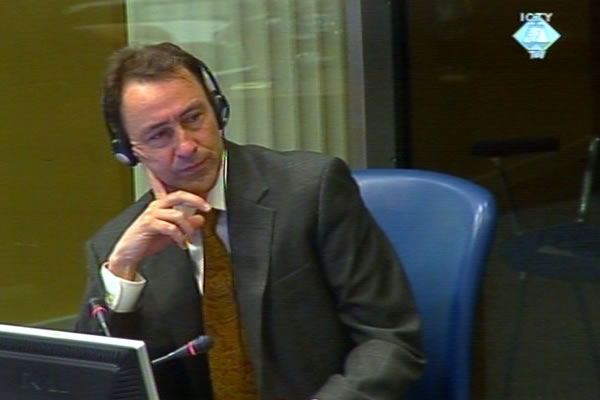Home
FOR KARADZIC, ATTACK IS THE BEST DEFENSE
Radovan Karadzic is trying to prove that in the summer of 1995 the VRS never intended to take Srebrenica and Zepa; constant attacks launched from the enclaves finally forced the VRS to do it. Prosecution witness David Harland denied Karadzic’s claim that no buildings in Sarajevo were destroyed by the Serbs
 David Harland, witness at the Radovan Karadzic trial
David Harland, witness at the Radovan Karadzic trial Continuing the cross-examination of David Harland, former head of the civil affairs in the UN mission in BH, the accused Radovan Karadzic tried to prove that the Bosnian Serbs in fact captured two enclaves in Eastern Bosnia, Srebrenica and Zepa, practically against their will in the summer of 1995. The former Republika Srpska president contended that the enclaves had never been demilitarized and were strongholds of the ‘Muslim army’, which prepared for an offensive to be launched from the enclaves. The VRS forestalled the offensive by launching its own. The accused tried to corroborate his claims using a number of documents from the UN, BH Army and the VRS, mostly disclosed to him by the Tribunal’s OTP. Karadzic is defending himself at the trial.
One of the documents that confirms for the most part Karadzic’s claim about the reasons why the enclaves were attacked is a report drafted by UNPROFOR commander, French general Janvier on 10 July 1995. The report states that the VRS launched the attack on Srebrenica to ‘reduce the size of the enclave’, secure roads, eliminate the threat by the BH Army and establish control over the nearby bauxite mine. Harland described this assessment as ‘inadequate’ and ‘dramatically incorrect’ because when the report was drafted, on 10 July 1995, the enclave ‘barely existed’. Twenty-four hours later, the enclave was simply ‘eliminated’. Harland added that generally speaking, the French general’s reports ‘often offered versions of events close to those provided by Serb sources’.
According to Harland, Karadzic’s infamous Directive 7 shows that the VRS goal was not just ‘to reduce the size of the enclave’ and the frontlines. In the Directive, Karadzic speaks about creating ‘unbearable living conditions’ for the residents of Srebrenica and Zepa. The document will be ‘hotly contested’ as the trial continues, the accused said, stressing that the defense will provide ‘quite adequate illustrations and clarifications’.
The accused went on to show several documents stating that Muslims in Srebrenica and Zepa were able to obtain various weapons throughout the war. The witness didn’t contest the claim and presiding judge Kwon noted that the prosecutor didn’t deny it. Harland reminded Karadzic that the provisions of the agreement reached by the warring factions and the international mediators did not envisage the withdrawal and disarmament of the BH Army in the enclaves. The witness strenuously denied the claims of the accused that UNPROFOR smuggled cigarettes and military equipment for the Muslims in the enclaves; Karadzic used VRS documents that purportedly show that. Harland said it was ‘pure rubbish’, adding that only food was delivered to civilians and military equipment was supplied to the UN soldiers. Convoys were often stopped and robbed at Serb check points, the witness noted.
Karadzic then moved on to Sarajevo, putting it to the witness that the living conditions in the city and in some other BH Army-controlled parts were far better than those in the Serb territories. Harland refused to be drawn into the debate, saying only that life during wartime in Banja Luka was ‘Beverly Hills’ compared to Sarajevo. The accused continued a detailed cross-examination about the situation in Sarajevo during wartime, the structure of units defending the city and crimes perpetrated by criminals in the BH Army ranks against Serbs. When the presiding judge warned him to bear in mind his questions needed to be relevant, Karadzic replied with a lengthy monologue. It was his wish, Karadzic explained, to show ‘who was on the other side’, that Sarajevo was a city where Serbs’ ‘heads were torn off literally’ and that ‘no building in Sarajevo was destroyed by the Serbs’.
Harland replied that the UN staff were able, using mortar-locating radars, to establish that 90 percent of the shells that hit the city were fired from the Serb-held positions. The accused contended he ‘will demonstrate tomorrow that it is not true’, indicating thus that he intended to spend the last day of his cross-examination probing the Markale town market incidents in February 1994 and August 1995. Harland spoke about those events in his examination-in chief on the first day of his testimony.
Linked Reports
- Case : Karadzic
- 2010-05-07 KARADZIC’S ‘INVERSION OF REALITY’
- 2010-05-06 ‘TURNING SARAJEVO’S TERROR TAPS’
- 2010-05-06 KARADZIC: ISLAMIC DECLARATION IS TO BLAME
- 2010-05-11 KARADZIC’S ‘CONTRADICTORY CLAIMS’ ABOUT THE MARKALE MASSACRES
- 2010-05-17 TRIAL CHAMBER CONCERNED OVER KARADZIC’S PROFLIGACY
- 2010-05-19 WITNESS: SARAJEVO WAS WORSE THAN BEIRUT
